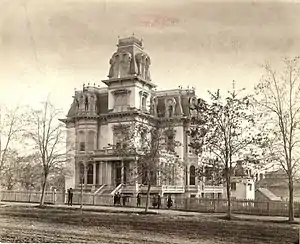Agnes Taylor
Agnes Taylor Rich Hoagland Schwartz (October 2, 1821 – December 11, 1911) was a Mormon pioneer who played a key role in helping her brother, LDS Church president John Taylor, evade authorities during the federal crackdown on polygamy in the mid-1880s. She was also the mother-in-law of later church president Joseph F. Smith and of William W. Taylor, and a wife of Abraham Hoagland.
Agnes Taylor | |
|---|---|
 | |
| Personal details | |
| Born | October 2, 1821 Westmoreland, England |
| Died | December 12, 1911 (aged 90) Salt Lake City, Utah |
| Spouse(s) | John Rich Abraham Hoagland Wilhelm Schwartz |
Early life and first marriage
Taylor was born to James and Agnes Taylor in an English village called Hale in Westmorland. Her older brother, John, would later become president of The Church of Jesus Christ of Latter-day Saints.
In 1838, 17-year-old Taylor married John Rich in Carthage, Illinois. They eventually settled in Nauvoo and had four children before divorcing when Taylor wanted to go west with the main body of Latter Day Saints in the late 1840s.[1][2]
Second marriage
In 1847, Taylor married 50-year-old Abraham Hoagland at age 26.[3] They had five children together[4] before divorcing in 1861[5] upon the recommendation of Brigham Young.[6] Their daughter Sarah married Taylor's nephew, William Whitaker Taylor.
Third marriage
In 1862, Taylor was 41 when she married Wilhelm Schwartz, a 24-year-old Prussian immigrant.[7] They had two children together, the second of whom, Mary Taylor Schwartz, married 43-year-old Joseph F. Smith in 1884 at the age of 18.

Protecting her brother
After Brigham Young died in 1877, Taylor's brother succeeded him as president of The Church of Jesus Christ of Latter-day Saints. John Taylor reluctantly moved into the Gardo House in 1882, three years after church members voted to make the then-uncompleted mansion the official parsonage for church presidents.
In 1882, Congress passed the Edmunds Act, which made polygamy a felony and posed a serious threat to Utah's long-stalled bid for statehood. Shortly after the law was passed, John Taylor called 16 general authorities to a meeting at the Gardo House. According to attendee Wilford Woodruff, "President Taylor with the rest of us came to the conclusion that we could not swap off the Kingdom of God or any of its Laws or Principles for a state government."[8]
Despite the church's decision to continue business as usual, John Taylor made an effort to comply with the Edmunds Act by moving his families out of the mansion and bringing his sister Agnes in[9] to take over its management while he continued his duties as president.[10][11]
Federal enforcement pressure increased, forcing John Taylor to withdraw from public view and go "underground": frequently on the move to avoid arrest. In March 1885, soon after his final public appearance, federal marshals made a massive raid on the house to capture him. This and subsequent raids were unsuccessful, and his "tough-minded sister ... often held raiding marshals and deputies at bay at the front door of the mansion, admitting no one unless he presented papers properly signed by a federal judge."[12][13]
After her brother's 1887 death while still underground, Taylor vacated the house.[14][15]
Death and legacy
Taylor died on December 12, 1911, in Salt Lake City, Utah.[16] Joseph F. Smith, Francis M. Lyman, Charles W. Penrose, Frank Y. Taylor, and Hyrum M. Smith each spoke at her funeral.[17][18]
Notes
- Black, Susan Easton. Members, LDS, 1830-1848, Vol 42. Provo, Utah. pp. 539, 615, 616.
- Black, Susan Easton (1980). Pioneers of 1847. Provo, Utah. p. 76.
- Hancock County Marriage Register. p. 38.
- The Utah Genealogical and Historical Magazine. Genealogical Society of Utah: vi. 1940.CS1 maint: untitled periodical (link)
- "Summary of Abraham Hoagland Journals: 1857 to 1870" (.pdf). George Q. Cannon Family Association. p. 5. Archived from the original on August 22, 2007. Retrieved 2007-08-17.
- Arrington, Leonard J. Brigham Young: American Moses. pp. 317–318.
- Pioneer Women of Faith and Fortitude. 4: 3021.CS1 maint: untitled periodical (link)
- Wilford Woodruff Journal, November 27, 1882, as cited in Heinerman, "Amelia's Palace."
- Cowley, Matthias F. (2006). Prophets and Patriarchs of the Church of Jesus Christ of Latter-Day Saints. Kessinger Publishing. p. 68. ISBN 1-4286-0180-5.
- Taylor, Samuel Woolley (1976). The Kingdom Or Nothing: The Life of John Taylor, Militant Mormon. Macmillan. pp. 302. ISBN 0-02-616600-3.
- Larson, Gustive Olof (1976). The "Americanization" of Utah for Statehood. Utah: Huntington Library. pp. 166–167. OCLC 155085.
- Journal History. March 13, 1885.CS1 maint: untitled periodical (link)
- "The Gardo House: A History of the Mansion and Its Occupants". Archived from the original on August 12, 2007. Retrieved 2007-08-29.
- "Letter from Wilford Woodruff to Agnes T. Schwartz." August 20, 1887 First Presidency Letterpress Copy Books. 1887—August–September.
- "First Presidency Letterpress Copy Books". Archived from the original on 2013-07-05. Retrieved 2007-08-29.
- Jenson, Andrew. "December 12, 1911 (Tuesday)". Church Chronology.
- "Tributes to Worth of Mrs. Agnes Schwartz: President Smith and Others Speak Highly of Life of Noble Woman". Salt Lake City, Utah: Deseret News. December 15, 1911.
- "Agnes Schwartz Biography". Retrieved 2007-08-29.